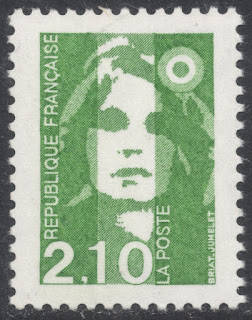As so many famous French stamp engravers had done before
him, Paris born Claude Jumelet (1946) studied at the Ecole Estienne, the famous
Graduate School of Arts and Printing Industry. After four years of study he
left, armed with diploma and medals, and went to work for the French Government
Printing Works, at the young age of 21.
There he developed further into one of the major
contributors to French philately. His introduction into the French stamp
catalogue formed part of the 1970 issue to mark the transfer of the Government
Printing Works to Périgueux. The stamp itself, the Marianne de Cheffer design,
was engraved by Claude Durrens but the
attached label was engraved by Jumelet. It would be the first of many issues
which in one way or another were pivotal in French philately.
Since then, Jumelet has engraved hundreds of stamps, not
only for France but also for countries such as Monaco and Tunisia and those of
the former French Empire. His work has even appeared in the United States, when
an American-designed, 1986 joint issue with France was given to Jumelet to
engrave. He has therefore rightly been bestowed the title of Grand Master of
France.
Jumelet is very passionate about the art of hand-engraving,
be it stamps or other formats. He has been a member of the French organisation Art
du Timbre Gravé, which safeguards and promotes the hand-engraved,
recess-printed stamp, for years. In 2008, he engraved one of their annual
complimentary souvenir cards.
Other philatelic souvenir items Jumelet engraved throughout
his career are the 1998 engraving of Ceres for the book Le patrimoine du timbre-poste français, and the souvenir sheetlet
for the 2004 Parisian stamp show Le Salon du Timbre, which comes in ten colours,
one for each day of the show, and a special ‘inauguration’ one.
Claude Jumelet has engraved quite a number of French
definitives, following in the footsteps of Pierre Gandon. His first Marianne
was the one introduced in 1989, Marianne de Briat. He also engraved her
successors, Marianne de Luquet of 1997 and Marianne de Lamouche of 2005. As the
names suggest, none of these were designed by Jumelet.
Jumelet has also tried a few times to have his own Marianne
designs chosen, but has so far failed to succeed. His first design, of 1997,
was criticised because his Marianne did not wear her symbolical phrygian cap,
which turned her basically into ‘Mrs. Anybody’. The French President, always
having the final say, therefore unsurprisingly chose a different design, that
of Eve Luquet, which Jumelet would proceed to engrave. And
bittersweet was the fact that when all designs were shown at that year's
Philexfrance stamp exhibition, the public overwhelmingly voted for Jumelet's
design. So at least he won the popular vote, if not the French President's
favour.
Jumelet submitted two other attempts, in 1989 and
2008, with privately pulled die proofs existing for both essays.
During Jumelet’s career, which already spans over five decades, many of
his engraved stamps have been awarded various prizes. Jumelet even managed to
win the coveted Grand Prix de l’Art Philatélique twice! The first time was in
2004, for his stamp depicting 15th century French illuminations, part of
the 2003 joint issue with India. In 2008 he won again, this time in the
sheet/booklet category, for his engraving of the ‘European Values’ booklet,
depicting democracy, the environment and peace.
You will find Claude Jumelet's database HERE.



